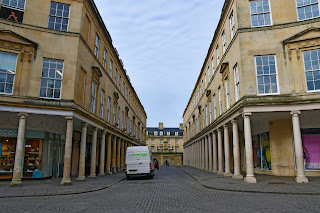Bath and Bristol
The first day trip on which I took my friend was a visit to Bath and Bristol. We arrived in Bath at the sensible hour of nine o’clock, which – come to think of it – happens to explain the absurd amount of money we paid for the train tickets there. I had reserved tickets to the Roman Baths for 10:15, so we spent a little over an hour simply wandering about the awakening town. Just like every proper spa town, it was bustling with retirees. What is remarkable about Bath is its unified appearance: practically every building in the centre is built of Bath stone, a sandy coloured type of limestone, and has the same grey roof.
We saw
quite a few sights during this initial round through Bath: the historic Cross
Bath, the outside of Holy Trinity Church and Saint Michael’s Church, Guildhall,
and Pulteney Bridge. Once the Abbey opened at 10:00, we also made a short
excursion inside. Perhaps its most remarkable feature is the ornate fan
vaulting, though the crypts are also impressive, and the angels climbing
Jacob’s ladder on the front of the building certainly make the place of worship
unique.
We entered the Roman Baths at our appointed time and were greeted immediately by an ornate domed ceiling. This, of course, was not built by the Romans; the springs have been used by humans since pre-Roman times and the buildings around them have ranged from classical to, well, neo-classical. Legend has it that they were founded by the mythical King Bladud, who cured himself of leprosy by imitating pigs that wallowed in the mud by the springs.
Our tour of the Roman Baths took longer than I expected, as the audio-guides had plenty of information about numerous exhibits. Among the many things I did not know about the baths is that they also served the role of a sacrificial temple. The carved face of what appears to be a water god – possibly an amalgamation of a pre-Roman deity and the god Oceanus – used to adorn its pediment, and the altar, as well as a gilt bronze statue of Minerva, have been excavated. Also interesting is the collection of small leaden tablets containing curses against petty thieves at the baths.
After
leaving the Roman Baths, we made our way to the Royal Crescent, which is a row
of fancy Georgian terraced houses that have been home to a number of British
luminaries. Having bought a fast lunch on our way back to the centre, we ate it
at the Parade Gardens, where we saw a particularly cheeky and chunky seagull
steal a sandwich straight out of a woman’s hands. Our last stop was the
incense-infused Church of Saint John the Evangelist, a Catholic church with an
unusual panelled ceiling.
We did not
spend as much time in Bristol, but we found it interesting regardless. Upon our
very arrival, we were surprised by how aesthetically pleasing the train station
was, with its multiple towers and central clock. Our first stop was Saint Mary
Redcliffe Church, a historically significant building. Mounted on the wall is
the armour of Sir William Penn, father of the William Penn after whom
Pennsylvania takes its name. When the elder Penn died, his son accepted land in
the colonies as compensation for the debt the crown still owed him. The church
also witnessed the marriage of Samuel Coleridge to Sara Fricker.
We crossed two bridges to arrive at out next destination: Bristol Cathedral. Its inside was a strange mix of opulence and austerity, with relatively simple vaults but also crypts framed by star-like stonework. We then passed back through the centre of town and walked along the river Avon, which, I have learned, is an unhelpfully common name for rivers in the UK. Our final stop was at the leaning tower of the ruined Temple Church, which stands on the site of an earlier house of prayer built by the Knights Templar. We returned to Oxford in time to have dinner at Saint Antony’s dining hall.






































































































Comments
Post a Comment